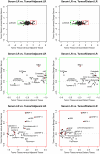Protein signature of lung cancer tissues
- PMID: 22509397
- PMCID: PMC3324437
- DOI: 10.1371/journal.pone.0035157
Protein signature of lung cancer tissues
Abstract
Lung cancer remains the most common cause of cancer-related mortality. We applied a highly multiplexed proteomic technology (SOMAscan) to compare protein expression signatures of non small-cell lung cancer (NSCLC) tissues with healthy adjacent and distant tissues from surgical resections. In this first report of SOMAscan applied to tissues, we highlight 36 proteins that exhibit the largest expression differences between matched tumor and non-tumor tissues. The concentrations of twenty proteins increased and sixteen decreased in tumor tissue, thirteen of which are novel for NSCLC. NSCLC tissue biomarkers identified here overlap with a core set identified in a large serum-based NSCLC study with SOMAscan. We show that large-scale comparative analysis of protein expression can be used to develop novel histochemical probes. As expected, relative differences in protein expression are greater in tissues than in serum. The combined results from tissue and serum present the most extensive view to date of the complex changes in NSCLC protein expression and provide important implications for diagnosis and treatment.
Conflict of interest statement
Figures









References
-
- Okada M, Nishio W, Sakamoto T, Uchino K, Yuki T, et al. Effect of tumor size on prognosis in patients with non-small cell lung cancer: the role of segmentectomy as a type of lesser resection. J Thorac Cardiovasc Surg. 2005;129:87–93. - PubMed
-
- Jemal A, Siegel R, Ward E, Hao Y, Xu J, et al. Cancer statistics, 2008. CA - Cancer J Clin. 2008;58:71–96. - PubMed
-
- Boyle P, Levin B, editors. World Cancer Report. Lyon: International Agency for Research on Cancer (IARC); 2008.
MeSH terms
Substances
LinkOut - more resources
Full Text Sources
Other Literature Sources
Medical
Research Materials

